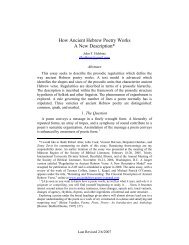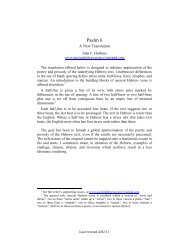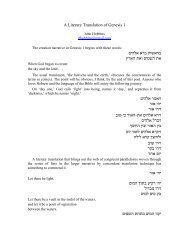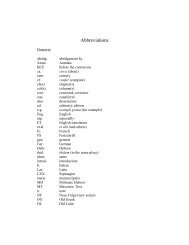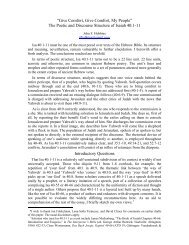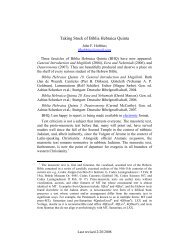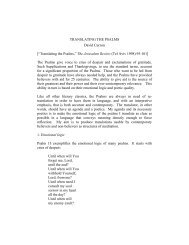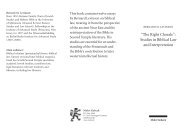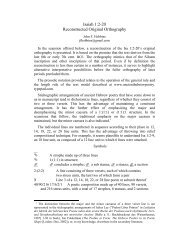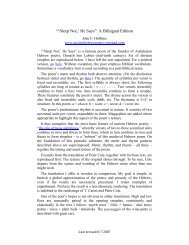Living Biblical Hebrew - Ancient Hebrew Poetry
Living Biblical Hebrew - Ancient Hebrew Poetry
Living Biblical Hebrew - Ancient Hebrew Poetry
Create successful ePaper yourself
Turn your PDF publications into a flip-book with our unique Google optimized e-Paper software.
<strong>Hebrew</strong> Alphabet 120The short vowels were used when a syllable was unaccented and closed, i.e. in an unaccentedsyllable ending in a consonant, CVC [consonant-vowel-consonant]. An open syllable has aconsonant and vowel, without a closing consonant: CV [consonant-vowel]. An open syllable in<strong>Hebrew</strong> either has a long vowel or an accented short vowel.NOTE WELL: The symbols for the long a and the short o are the same. When the symbol [ ] isfound in a closed, unaccented syllable it is pronounced o. Stated another way, an o sound is writtenwith when it is unaccented and in a closed syllable. Due to the history of the language, the long a vowel is more common than the short o vowel.Dagesh and begedkefet lettersA dot called dagesh is used in consonants 4 for two functions.1. In general, the dagesh marked a lengthened consonant; it was pronounced momentarily longer.A lengthened consonant would function as a double consonant, one consonant closing a syllableand one consonant beginning the next syllable. Thus, hab-báyit, and hil-lél. In modern<strong>Hebrew</strong>, these lengthened consonants are not pronounced differently and they are notdistinguished on the recordings in this course. 5 Grammar books call this dagésh azáq “strongdagesh” or dagésh kaflán “doubling dagesh”.2. The dagesh is also used with a select group of consonants to distinguish a stop, a hardpronunciation, from a fricative, a soft pronunciation. The group of consonants is , , , , , .These consonants are often called by an acronym begedkefet or begadkefat. A Basic Rule:begedkefet letters are soft when following a vowel and they are written without dagesh. Whenfollowing a consonant they are hard, and written with dagesh. 6 This is an automatic process thatis not related to meaning. The dagesh makes a difference in pronounciation on three of theseconsonants today. Thus , , and with dagesh are pronounced as the stops b, k, p. On theother hand, , , and without dagesh are pronounced as soft fricatives v, x, f. (The symbol x islike German ch.) These three letters, , , and are the only begadkefat letters that have twopronunciations in Israeli <strong>Hebrew</strong>. 7 The remaining three consonants, , , (g, d, t), are always4 The dot in o and u are considered vowels and are not the dagesh in a consonant. There is also a dot ina final called mappiq, which marks a pronounced h and will be learned later.5 One verb pattern is built around a lengthened (doubled) consonant in the middle of the word, e.g., hillel ‘hepraised’, dilleg ‘he jumped’, dibber ‘he spoke’. These are now pronounced hi-lel, di-leg, di-ber.6 For grammatical analysis of words it is important to learn that begedkefet letters receive a dagesh wheneverbeginning a word of a new phrase or when following a closed syllable, i.e., when following a consonant, not avowel. Such a dagesh in a begadkefat letter does not represent a grammatical lengthening of the consonant, itonly affects allophonic spelling rules, half of which are pronounced today. Stated from the other direction,when a begadkefat consonant follows a vowel within a phrase it does not receive a hardening dagesh (evenacross word boundaries within a phrase), though it may receive a lengthening dagesh. For example, in ‘he will speak’, the is following a half-vowel, i.e., not a vowel-less consonant (see below under shva), anddoes not receive a dagesh. The is also following a vowel [ ] and might have been expected to be withoutdagesh since it is a begadkefat letter. However, this word has a lengthened consonant at this point so the has a lengthening dagesh and gets pronounced as a hard b in spite of following a vowel. Grammatically,yedab- is analyzed as a complex, closed syllable and -ber is a closed syllable. Practically, for those learningto speak, is like three syllables: ye-da-ber.7 In the times of the judges the begedkefet letters were probably all pronounced as stops, likeEnglish b,g,d,k,p,t. By the Second Temple period each of these stops had a corresponding fricativepronunciation when immediately following a vowel within a word or small phrase and when not lengthenedby the lengthening dagesh. The phonetic symbols for such fricatives are v, γ, δ, x, f, θ . In modern <strong>Hebrew</strong>,only three of these pairs are pronounced, /b~v/, /k~x/, and /p~f/. The remaining three consonants, (g,d, t), are always pronounced hard as stops, regardless of whether the hardening dagesh is present or written.



